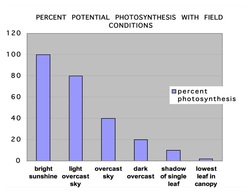 Our eyes don’t allow us to be aware of differences in light intensity but the photosynthesis rate in corn leaves is very sensitive to this factor. Having a C4 photosynthesis system, the rate of photosynthesis in an exposed chloroplast increases directly with light intensity up to full sunlight. C3 plants, such as soybeans, can only use 3/10ths of full sunlight hitting the leaves. Several years ago, I carried a light meter to measure foot candles in many corn environments to help me understand light intensity differences. Measuring in foot candles is not quite as good as PAR (Photosynthetically Active Radiation) measurements as done with more recent instruments but it did demonstrate to me the differences in light intensity within corn environments. Full, unobstructed sunlight has intensity of 10000 fc (foot- candles) when measured in Ohio, Illinois and in Colorado. However, the measurement in the shadow of a single corn leaf is only 1000 fc. That portion of the leaf in the shade of the single leaf is only producing 1/10th the carbohydrate as the same area of the leaf fully exposed to direct sunlight. The lowest leaf in a canopy receives only about 50fc, hardly enough to sustain its own tissue and is one of the reasons that these leaves disintegrate. As shown in the graph above, cloudy days also reduce the photosynthetic rate in corn plants. It is a precarious balance between sugar demands established in the ear after pollination and factors affecting photosynthesis in fields. Growers are in control of some factors such as hybrid selection, fertilizers and plant density but others such as rain affecting kernel numbers, or leaf diseases potentially removing effective leaf area and cloudy weather can drastically affect whether the corn plant stays alive until the completion of grainfill. Comments are closed.
|
About Corn JournalThe purpose of this blog is to share perspectives of the biology of corn, its seed and diseases in a mix of technical and not so technical terms with all who are interested in this major crop. With more technical references to any of the topics easily available on the web with a search of key words, the blog will rarely cite references but will attempt to be accurate. Comments are welcome but will be screened before publishing. Comments and questions directed to the author by emails are encouraged.
Archives
December 2021
Categories
|
 RSS Feed
RSS Feed